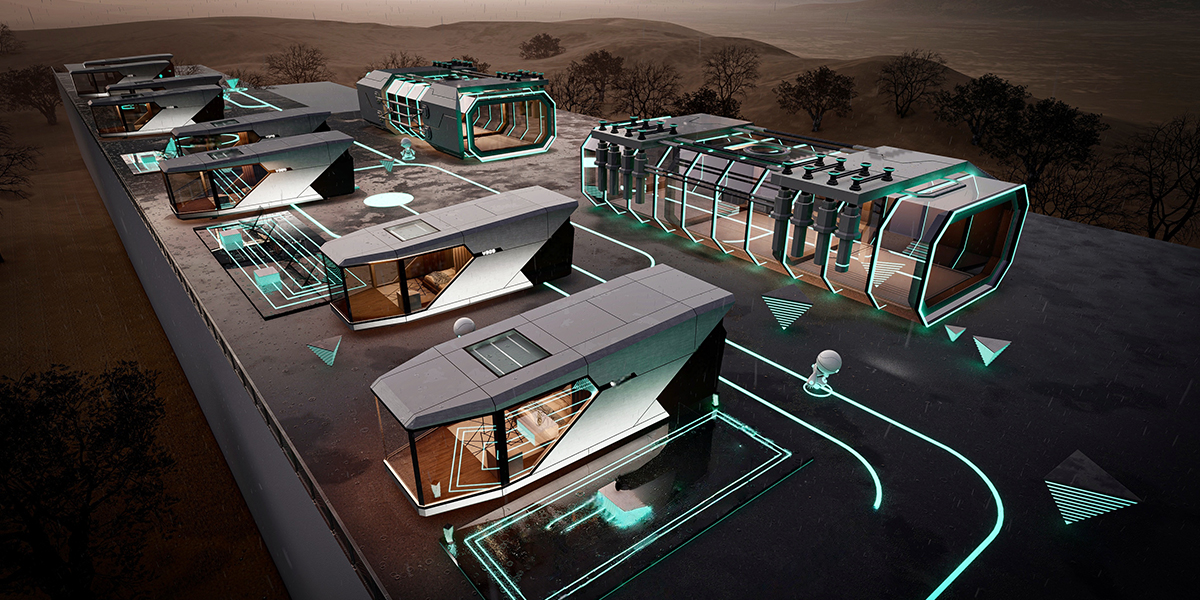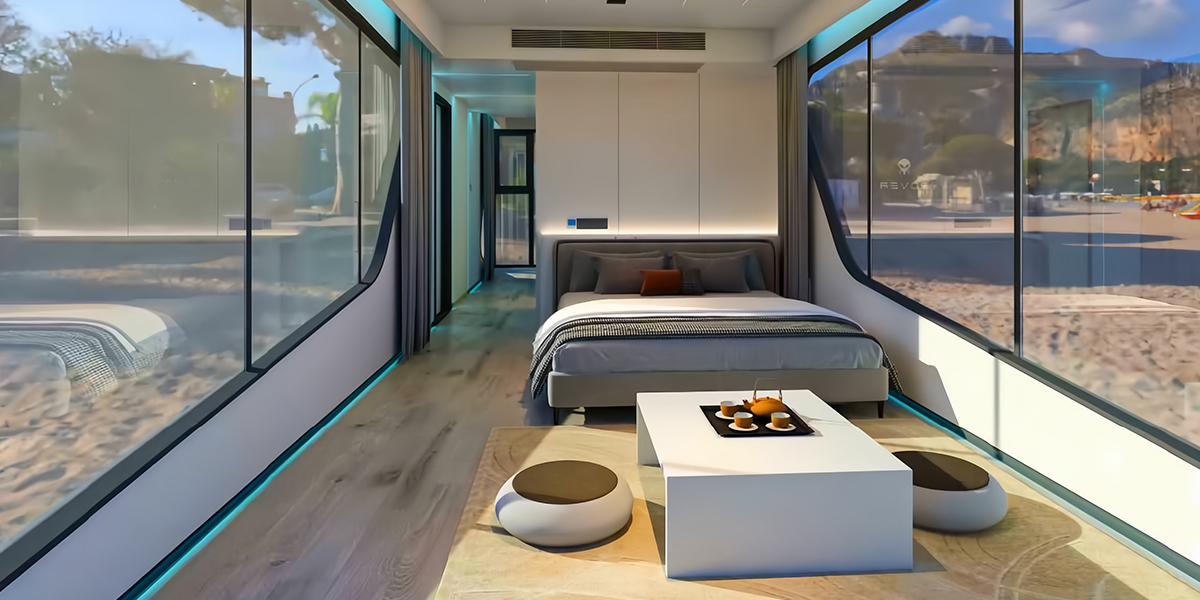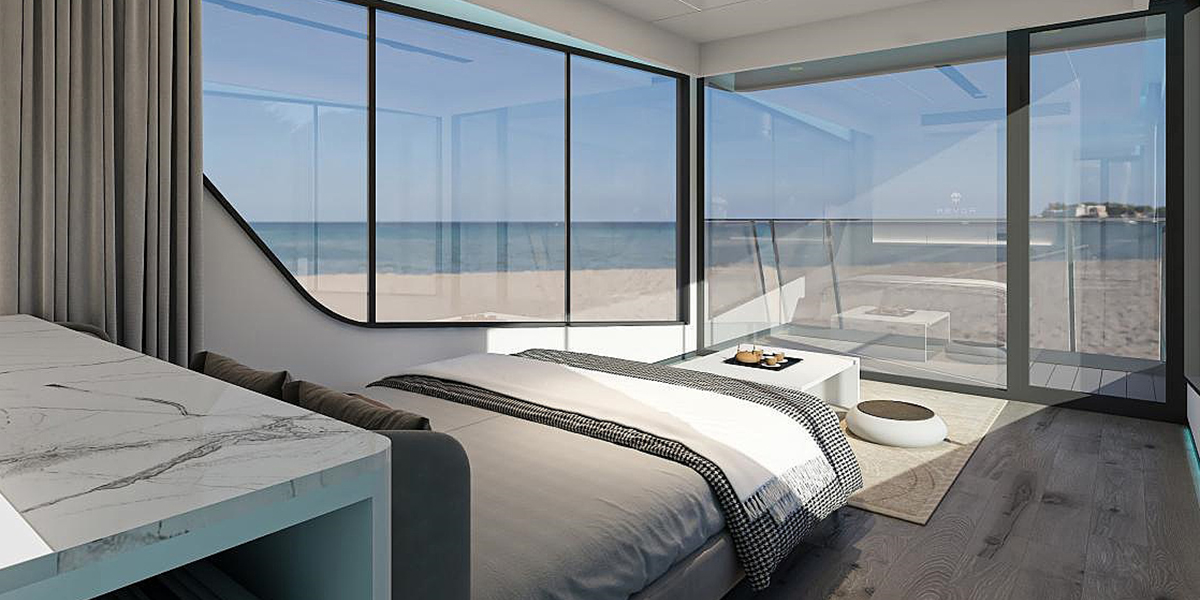
22 Jul What Buyers Need to Know Before Choosing a Capsule House
Table of Contents
Are you wondering if capsule homes are the right choice for you? Many people choose capsule homes to live simply and save money. You might appreciate that these homes use eco-friendly materials and require very little space. They are easy to move and help you make the most of small plots of land, especially in busy cities. If you’re interested in capsule houses for sale, consider what matters most to you before making a purchase. Make sure any capsule houses for sale you look at will fit your future plans and lifestyle needs.
Key Takeaways
Capsule homes cost less and are good for the environment. They use small spaces in a smart way. These homes are great for people who want a simple life. They are also easy to move.
Buyers need to think about extra costs. These can be permits, getting the land ready, and connecting utilities. These costs are not part of the main price of the capsule house.
Capsule homes do not have much space. You must pick what you really need. You should be ready to live with fewer things.
Pick sellers who have good reviews and certifications. This helps make sure you get a safe and good-quality home. It also helps the building process go well.
Good insulation and strong materials keep capsule homes comfy all year. They do not need much care. They last a long time and keep their value.
Capsule House Buying Basics
Is a Capsule House Right for You?
Capsule homes are a special kind of prefab homes. They focus on simple living and easy moving. These homes use space in a smart way. When you think about capsule house buying, ask if this life is right for you. Many people pick capsule homes to have less stuff. They also want more freedom in how they live.
Capsule homes are best for some people. Millennials may like small homes that are easy to care for. Young workers and people who move a lot often choose capsule homes. They can take their home with them and set it up anywhere. Remote workers like capsule homes too. Many have workspaces built inside. If you care about the planet, you will like that capsule homes use green materials. They help you live in a way that is better for the earth. People with less money, especially in cities, find capsule homes cheap. Monthly costs are often between $600 and $800.
Before you buy a prefab house, think about your daily life. Do you need lots of space or can you live in a small area? Are you ready to live with fewer things? These are important things to think about. You also need to look at local rules and zoning laws. Some places make it hard to put prefab homes there. Always talk to city workers before you buy a capsule house.
Tip: Write down what you must have and what you want. This will help you see if a capsule home is right for you.
Main Pros and Cons
Capsule house buying basics mean knowing the good and bad sides. Let’s look at the main advantages of prefabricated homes and the disadvantages of a prefab house. This helps you make a smart choice.
Advantages
Affordable: Capsule homes cost less to build and keep up than regular houses. You save money on bills and fixing things.
Sustainability: Many capsule homes use eco-friendly materials. They can cut your carbon footprint by up to 45%. Prefab homes use about 65% less energy than normal houses.
Quick Setup: Buying a prefab house means you can move in fast. It takes about 4-6 weeks to make one. Shipping is often part of the price.
Minimal Maintenance: Prefabricated homes need less care. The materials last a long time, so you spend less on repairs.
Mobility: You can move your capsule home if your job or life changes. This is good for people who travel or move a lot.
Space Efficiency: Smart layouts and furniture help you use every inch. You can live simply and keep your space neat.
Disadvantages
Limited Space and Storage: Capsule homes are small. You need to change how you live and find smart ways to store things.
Less Privacy: Open designs mean fewer walls and less room to be alone.
Building Codes and Zoning Regulations: Some cities have strict rules for prefab homes. You might have trouble getting permits or meeting local laws.
Lifestyle Adjustment: Moving into a capsule home means having fewer things. This can be hard if you are used to more space.
Resale Value: Prefabricated homes sometimes sell for less than regular houses.
Here’s a quick look at the main pros and cons:
Advantages | Description |
|---|---|
Affordability and Cost Efficiency | Capsule homes are cheap to buy and keep up. |
Sustainability and Energy Efficiency | They use green materials and save energy. |
Space Efficiency and Minimalist Living | Smart layouts help you live with less stuff. |
Mobility and Modularity | You can move your home when you need to. |
Disadvantages | Description |
|---|---|
Limited Space and Storage | You have less room for your things. |
Less Privacy | Open spaces mean less room to yourself. |
Building Codes and Zoning Regulations | Local rules can make setup hard. |
Lifestyle Adjustment | Having fewer things can be tough. |
When you start buying a prefab house, follow some key steps. First, look at different prefab homes and find a seller you trust. Check the materials and make sure the home meets local rules. After you pick your capsule house, you usually pay half the price up front. The company builds your home in about 4-6 weeks. Then they ship it and handle customs. You must get your land ready with a flat, strong surface. Make sure water and power are set up. Always check the legal papers and get the right permits. If you see any damage when it arrives, tell the company right away.
Buying a prefab house can be a smart choice if you want a cheap, green, and flexible home. Still, you need to think about the factors to consider before buying a prefab home, like space, privacy, and local laws. Take your time, do your homework, and make sure a capsule home fits your needs before you buy a capsule house.
Key Benefits and Challenges
 Affordability and Hidden Costs
Affordability and Hidden Costs
Prefab homes can look cheap at first. Capsule homes cost less than normal houses. You pay less for the building. You also save money each month because energy-efficient capsule houses use less power. But owning a capsule house costs more than just the price you see.
Most buyers think about the first price. But there are extra costs you need to plan for. Here are some examples:
Moving your home from the port to your land
Using a crane to put your capsule house in place
Paying for permits from the city or town
Hooking up water, power, and sewage
Getting the ground ready with a base or stilts
Hiring someone local to help set up and follow rules
Buying insurance in case something gets broken
The main price covers the capsule house and shipping to the closest port. Other things, like moving from the port, permits, and hooking up utilities, are not included. You have to pay for these on your own. Here is a simple chart to show what is and isn’t included:
Cost Component | Included in Base Price? | Notes and Additional Details |
|---|---|---|
Delivery to Nearest Port | Yes | Shipping to nearest port includes all duties, taxes, and customs clearance. |
Delivery from Port to Site | No | Customers must arrange trucking/transportation from port to site separately. |
Crane Services | No | Required for unloading and placing the capsule house; must be arranged locally. |
Permits | No | Permitting depends on local/state rules; customers must get these, often with local help. |
Utility Hookups | No | Water, sewer, and power connections must be done by the customer or local workers. |
Foundation/Base | No | Getting the land ready, like a base or stilts, is not included and must be done by you. |
Tip: Always ask the seller for a full list of costs before you buy. This helps you plan and not get surprised.
Capsule homes are cheap, but you need to look at all the costs. Even with extra steps and fees, prefab homes are still a good deal.
Space and Functionality
Capsule houses are smaller than most studio apartments. You usually get 50 to 500 square feet to live in. Studio apartments often start at 300 square feet or more. Prefab homes use smart designs and built-in furniture to save space. You might have a bed that folds into a couch or a table that hides in the wall.
Some space-saving ideas in capsule homes are:
Furniture that does more than one thing, like beds that turn into seats
Designs you can change to fit your needs
Stacking homes on top of each other in cities
Smart tech to make life easier and save space
Small layouts with a bedroom, bathroom, and tiny kitchen
Some prefab homes use mirrors and clear walls to make rooms look bigger. Many use smart layouts so you can move around easily. Some even have different spots for sleeping, working, and storing things.
Living in a capsule home means you need to change how you live. You have less space, so you must pick what is most important. Prefab homes are best for people who want a simple life and do not need a lot of stuff. If you like privacy, remember that open layouts in capsule houses can mean less quiet time.
Note: If you like to collect things or need lots of storage, prefab homes might feel too small. But if you want a tidy, easy-to-clean home, you will like how capsule homes use every bit of space.
Sustainability and Materials
Capsule houses are great for the planet. Builders use strong, green materials that last a long time and need little care. The outside is often made of aviation-grade aluminum. This is light, strong, and stands up to sun and rain. The frame is usually steel that does not rust, so your prefab home stays safe for years.
Insulation is very important in capsule homes. You get panels with foam or polyurethane inside. These keep your home warm in winter and cool in summer. Good insulation means you pay less for heating and cooling. This saves money and helps the earth. Some prefab homes use special glass that makes power from sunlight, so they save even more energy.
Other materials you might see are:
Magnesium boards that do not burn and stop mold
Plastic with fiberglass for strength and bending
Floors made from mixed materials that last in any weather
Prefab homes use fewer materials than normal houses, so they make less trash. Building in a factory also means less pollution. Many prefab homes meet green rules like LEED or GreenGuard, so you know they are safe and healthy.
Capsule homes also have good airflow. Smart designs let fresh air in and keep the home comfy. Good airflow and insulation work together to make prefab homes cozy and save energy.
Capsule houses can last 60 years or more if you take care of them. Steel frames can last over 80 years. With the right care, your prefab home keeps its value and stays strong for a long time.
🌱 If you care about the earth, prefab homes are a smart pick. You get a home that saves energy, uses less water, and is better for the planet.
Finding Capsule Houses for Sale
 Reputable Sellers
Reputable Sellers
When you start looking for capsule houses for sale, you want to work with sellers you can trust. Not every company is the same. Some have more experience and better service. Here’s what to look for in a capsule house seller:
Check their reputation on sites like the Better Business Bureau and Trustpilot. Read reviews and see if customers had problems.
Make sure the company builds capsule homes and has a good website with lots of details and photos.
Ask if the capsule house fits your needs. Some are for full-time living, while others work best for vacations.
See if the seller ships to your area. Not all capsule houses for sale are available everywhere.
Look for clear instructions and a list of tools for assembly.
Find out if you need special skills, like wiring or plumbing, to set up your capsule home.
Ask about site prep, like grading land or adding utilities.
Read what other buyers say about the assembly process.
You should also check for important certifications. Good sellers meet standards like ISO9001, SGS, and CE. They use safe, strong materials and follow building codes. This helps you get a safe and long-lasting capsule home.
🏆 Tip: Always ask for proof of certifications and read customer reviews before you buy.
Assembly and Setup
Capsule houses for sale come ready to assemble, but you need to plan. The process starts with making your land ready. You need permits, a flat spot, and utility hookups. The company builds your capsule house in about 4 to 6 weeks. Shipping takes 2 to 5 weeks more.
When your capsule home arrives, you need a truck and a crane to move it. The path to your site should be at least 12 feet wide. The crane lifts the capsule house onto your land. After that, you connect water, power, and sewer. You might need to build stairs or decks.
Most people can move in about 6 to 11 weeks after ordering. If you plan ahead and work with local helpers, the setup goes smoothly.
Customization Options
Many capsule houses for sale let you pick features that fit your style. You can choose colors, flooring, and lighting. Some sellers offer smart home systems, electric curtains, and special glass for energy savings. You might add custom cabinets or change the layout.
Capsule homes often use strong materials like aerospace aluminum and steel. You can ask for extra safety features, like fire alarms or weather protection. Some companies let you add smart controls for lights and temperature.
Keep in mind, custom options can raise the price and add a little time to delivery. If you want something special, talk to the sales team for details.
Note: Customizing your capsule house makes it feel like home, but it’s smart to ask how changes affect cost and timing.
Budgeting for Capsule House Buying
Purchase Price and Financing
When you start buying a prefab house, you need to look at all the costs. The price you see online covers the capsule house itself and shipping to the nearest port. You will pay extra for delivery from the port, permits, utility hookups, and setting up the land. These costs can add up fast, so planning is key.
You have several options for financing and budgeting for a capsule house. Many companies, like Nestron, work with trusted U.S. partners to offer loans made for prefab homes. You can place a deposit online and finish your order with financing if you qualify. Some buyers use conventional loans, which need a credit score of at least 620. First-time buyers may only need a 3% down payment. These loans usually cover completed homes, not DIY builds. Remember, you must also budget for land, site prep, and utility hookups, since most loans do not include these.
💡 Tip: Ask your seller if they offer free consultations to help you understand your financing options.
Ongoing Maintenance
Capsule houses use strong materials like aviation-grade aluminum and steel. These materials last a long time and need less care than regular homes. You will spend less on repairs because the design stands up to bad weather and daily use. Most capsule houses keep 70–80% of their value after ten years, which shows they are durable.
You should still do regular cleaning, check for leaks, and keep up with HVAC and plumbing. These tasks are simple and do not take much time. The main structure can last over 50 years, much longer than many tiny homes. This means you save money on upkeep over time.
Utility Connections
Connecting water, power, and sewage is a big part of buying a prefab house. You must hire local, licensed contractors for these jobs. The costs depend on your site and the type of utilities you need. Here is a quick look at average prices:
Utility Type | Average Cost Range (USD) |
|---|---|
City Water | $1,000 to $6,000 |
Well Water | $5,000 to $10,000 |
City Sewer | $1,500 to $5,700 |
Septic System | $3,400 to $11,500 |
Electricity Hookup | $1,000+ or $5–$15/ft |
You need to plan for delivery trucks and cranes, too. Make sure your land is easy to reach and clear of trees or fences. Permits and local rules can slow things down, so start early. Always check that your contractors have insurance and know the local codes.
🚧 Note: Utility connection costs can range from $6,000 to $30,000 or more. Plan ahead to avoid surprises.
Before you choose a capsule house, take time to do your homework. Look for sellers with good reviews and clear business practices. Set a budget that covers the house, land, utilities, and future costs. Check the location for zoning rules and easy access to work or schools. Review the contract, warranty, and support options.
🏡 Remember: Smart features, strong materials, and a good layout make life easier. Talk to a pro if you have questions. Make sure your new home fits your needs and plans.
FAQ
How long does it take to get a capsule house delivered?
You usually get your capsule house in 6 to 11 weeks. This time covers building, shipping, and setup. Ask your seller for updates so you know what to expect.
Can you live in a capsule house year-round?
Yes, you can live in a capsule house all year. Good insulation and strong materials keep you warm in winter and cool in summer. Just make sure your utilities work in every season.
Do capsule houses need a lot of maintenance?
No, you do not need much maintenance. Clean your home, check for leaks, and keep up with small repairs. The materials last a long time and stand up to bad weather.
Can you move a capsule house to a new location?
Yes! You can move your capsule house if you need to. You will need a truck and a crane. Make sure your new land is ready and has the right permits.
What should you check before buying a capsule house?
Always check:
The seller’s reputation
Local zoning rules
Utility hookup options
Warranty and support
These steps help you avoid problems and enjoy your new home.




 Affordability and Hidden Costs
Affordability and Hidden Costs Reputable Sellers
Reputable Sellers